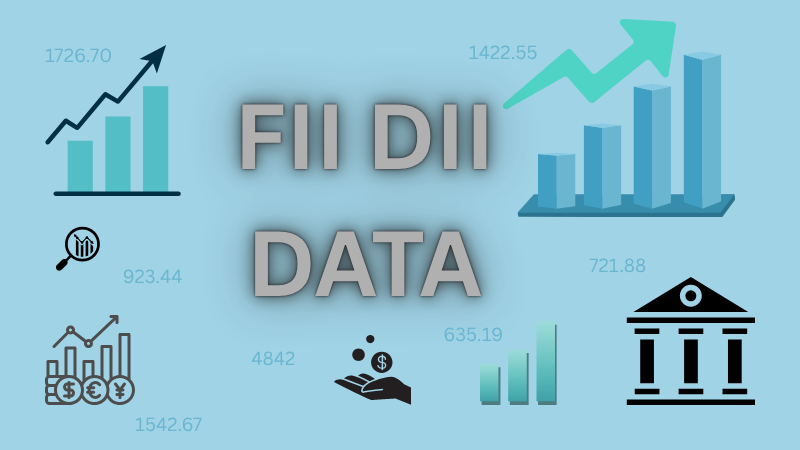FII DII Data – What It Is, How It Works, and Why It Matters
FII DII Data 2025 – The Ultimate Powerful Guide to Institutional Activity and Market Trends
Introduction
If you actively trade or invest in the Indian stock market, you’ve probably heard about FII DII data.
It’s one of the most powerful tools to understand market sentiment, foreign money flow, and institutional behaviour.
But what exactly is it?
Why does every trader check FII buying and selling data today before market hours?
And most importantly — how can you use this data to predict the market’s next move?
Let’s dive deep into everything about FII DII Data NSE, how it works, how to read it, and why it’s critical for smart trading decisions.

What is FII and DII?
- FII (Foreign Institutional Investors):
These are large investment firms, hedge funds, or foreign entities that invest in Indian markets from abroad.
Their activity shows how international investors view India’s growth and economic stability. - DII (Domestic Institutional Investors):
These include mutual funds, insurance companies, banks, and other domestic financial institutions investing within India.
In short — FIIs bring foreign capital into the market, while DIIs represent local institutional confidence.
Tracking both together gives you the real picture of market sentiment — called FII DII Data.
How Does FII DII Data Work?
Every trading day, both FIIs and DIIs buy and sell securities in the Indian stock exchanges — NSE and BSE.
At the end of the trading session, their net activity (buying minus selling) is published as the official FII trading activity report.
For example:
- If FII buying stocks today = ₹9,000 crore
- And FII selling = ₹7,500 crore
Then Net FII = +₹1,500 crore (which indicates a bullish inflow).
Similarly, if DIIs are net sellers, it means local institutions booked profits while foreign money entered the market.
These flows are crucial to analyze whether the market is under accumulation (bullish) or distribution (bearish).
If you want to know what trading is and you’re unsure which type of trading to pursue, you should definitely read this article, “Beginner Trading Roadmap.” In it, you’ll learn many things related to trading and find out which type of trading is right for you.
Where to See Official FII DII Data
You can access official FII DII data NSE directly from the National Stock Exchange website.
👉 Official Link: https://www.nseindia.com
There, you’ll find:
- Today FII DII data (daily summary)
- FII DII data monthly reports
- FII DII data last 10 days trend comparison
For more advanced tools, platforms like Zerodha and Sensibull also offer visual insights:
- FII DII Data Zerodha: check the console insights or Varsity learning modules.
- FII DII Data Sensibull: shows derivative flow, open interest, and sentiment charts — useful for option traders.
You can even get FII DII data live updates from financial news portals and stock analytics dashboards.
Why is FII DII Data Important?
Institutional money drives the market.
Retail traders follow trends — but institutions create trends.
Here’s why FII activity matters:
- Market Direction Indicator: If FIIs are buying heavily, the market usually trends upward.
- Liquidity Signal: FIIs and DIIs control nearly 80% of trading volumes.
- Confidence Gauge: FII inflow means foreign investors trust India’s economy.
- Volatility Predictor: Sudden outflow hints at potential corrections or global tension.
- Sector Rotation Insight: You can see which sectors institutions are accumulating or exiting.
In short — knowing FII buying stocks today or fii buying and selling data today helps you decide whether to go long or short with confidence.
How FII DII Data Helps You Understand Market Trends
When FIIs buy and DIIs sell, markets usually move up (foreign liquidity > local profit booking).
When both sell, markets crash.
When both buy — that’s a strong bullish confirmation.
Example:
| FII Net (₹ Crore) | DII Net (₹ Crore) | Market Trend |
|---|---|---|
| +2,300 | -800 | Bullish (FII-driven) |
| -1,200 | +1,700 | Sideways |
| -3,000 | -1,000 | Bearish |
| +1,800 | +1,200 | Strong Bullish |
So, by combining FII DII data live and price movement, you can predict short-term direction effectively.
Advantages and Disadvantages of Tracking FII DII Data
Advantages
- Provides institutional sentiment clue before major moves.
- Helps identify “smart money” flow zones.
- Improves entry/exit timing for swing and positional trades.
- Useful for option traders on platforms like Sensibull or Zerodha for direction bias.
- Works as a leading indicator for Nifty and BankNifty trends.
Disadvantages
- Intraday traders often misread it — because FII DII data is published post-market, not real-time.
- Can be misleading if used without technical confirmation.
- Sometimes FIIs hedge with derivatives — making cash market data look neutral or opposite.
- Data updates late on volatile days (due to settlement delays).
Hence, FII DII analysis should be combined with price action, sector rotation, and volume studies for accuracy.
How FII DII Data Affects Market and Economy
When FIIs invest, the rupee strengthens, liquidity improves, and corporate valuations rise.
Conversely, when FIIs pull out, currency weakens, bond yields rise, and equity markets correct sharply.
A consistent inflow of foreign money boosts:
- GDP growth through higher corporate investments.
- Government tax revenues from capital markets.
- Investor confidence in India as an emerging economy.
Therefore, tracking FII DII Data NSE is not just for traders — it’s for anyone interested in India’s economic health.
How to Use FII DII Data for Trading Strategy
- Trend Confirmation:
When FIIs are net buyers for 3+ consecutive days → go long on index stocks. - Reversal Signal:
When FIIs stop buying suddenly → prepare for correction. - Pair Analysis:
Combine FII DII data monthly with sectoral indices to identify where big money is rotating. - Intraday Setup:
Use “Today FII DII Data” from NSE + option OI change data (from Sensibull) for short-term bias. - Diversified View:
Don’t just see net value — check consistency over FII DII data last 10 days for real insight.
FAQ – Frequently Asked Questions
Q1. What is FII DII Data in the stock market?
It’s the record of foreign and domestic institutional buying and selling activity on the Indian stock exchanges, updated daily by NSE and BSE.
Q2. Where can I find Today FII DII Data?
Visit the official NSE website → “Market Data” → “Reports” → “FII/FPI & DII Trading Activity.”
Q3. What does FII DII Data tell us?
It tells whether institutions are investing (bullish) or withdrawing funds (bearish) from Indian markets.
Q4. How to check FII DII Data Zerodha or Sensibull?
Zerodha provides institutional activity updates under “Console” or “Varsity.” Sensibull displays FII derivative positions for option traders.
Q5. Why is FII DII Data important for traders?
Because institutional flows control liquidity and direction — understanding FII activity helps you trade with the smart money, not against it.
Q6. Is tracking FII DII Data always useful?
Mostly yes — but it should be analyzed with price action and volume, not blindly.
Conclusion
Understanding FII DII Data is like having a roadmap to market direction.
Foreign investors bring momentum, domestic institutions bring stability — and together, they define where the market is heading.
Whether you’re analyzing FII buying and selling data today, using FII DII Data Zerodha, or comparing FII DII Data last 10 days, the insight remains the same:
Follow institutional footprints — not rumors.
The next time you look at FII DII Data NSE, remember — this isn’t just a number; it’s the pulse of the market.
